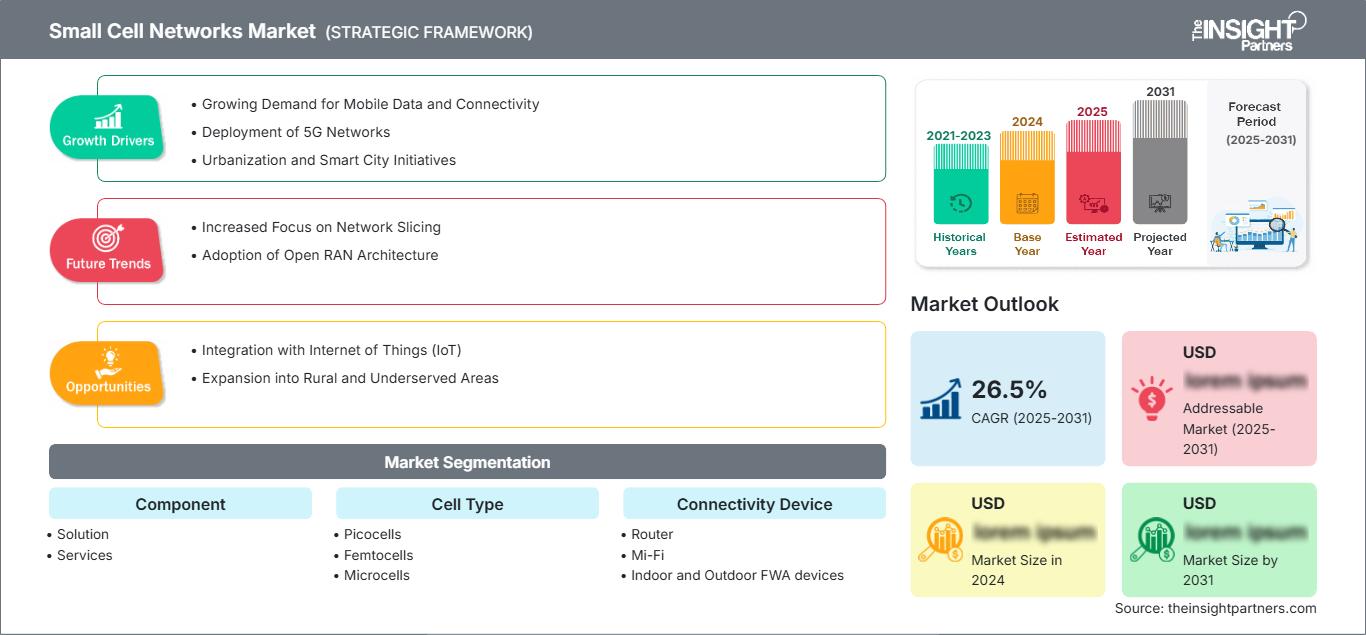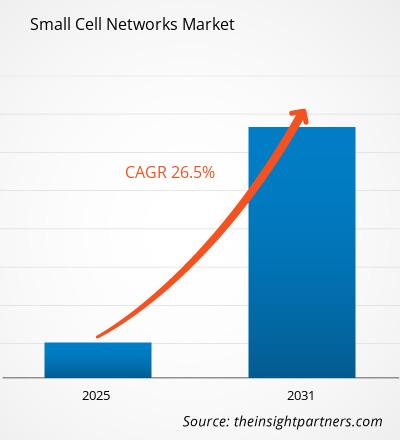Se espera que el mercado de redes de células pequeñas registre una CAGR del 26,5 % entre 2025 y 2031, y que el tamaño del mercado se expanda de US$ XX millones en 2024 a US$ XX millones en 2031.
El informe está segmentado por componente [solución, servicios (consultoría, implementación e integración, capacitación, soporte y mantenimiento)]; tipo de celda (picoceldas, femtoceldas, microceldas, metroceldas); dispositivo de conectividad (router, Mi-Fi, dispositivos FWA para interiores y exteriores, puerta de enlace, otros); implementación (exterior, interior); usuarios finales (residencial, comercial, industrial). El análisis global se desglosa a nivel regional y por países principales. El informe ofrece el valor en USD para el análisis y los segmentos mencionados.
Propósito del Informe
El informe "Mercado de Redes de Celdas Pequeñas" de The Insight Partners busca describir el panorama actual y el crecimiento futuro, los principales factores impulsores, los desafíos y las oportunidades. Esto proporcionará información a diversas partes interesadas del negocio, como:
- Proveedores/fabricantes de tecnología: Para comprender la dinámica cambiante del mercado y conocer las oportunidades potenciales de crecimiento, lo que les permitirá tomar decisiones estratégicas informadas.
- Inversores: Realizar un análisis exhaustivo de tendencias respecto a la tasa de crecimiento del mercado, las proyecciones financieras del mercado y las oportunidades que existen en toda la cadena de valor.
- Órganos reguladores: Regular las políticas y las actividades policiales en el mercado con el objetivo de minimizar el abuso, preservar la confianza de los inversores y defender la integridad y estabilidad del mercado.
Segmentación del mercado de redes de células pequeñas
Componente
- Solución
- Servicios
Tipo de célula
- Picocélulas
- Femtoceldas
- Microcélulas
- MetroCell
Dispositivo de conectividad
- Enrutador
- Mi-Fi
- Dispositivos FWA para interiores y exteriores
- Puerta
Despliegue
- Exterior
- Interior
Usuarios finales
- Residencial
- Comercial
- Industrial
Obtendrá personalización en cualquier informe, sin cargo, incluidas partes de este informe o análisis a nivel de país, paquete de datos de Excel, así como también grandes ofertas y descuentos para empresas emergentes y universidades.
Mercado de redes de células pequeñas: Perspectivas estratégicas

-
Obtenga las principales tendencias clave del mercado de este informe.Esta muestra GRATUITA incluirá análisis de datos, desde tendencias del mercado hasta estimaciones y pronósticos.
Factores que impulsan el crecimiento del mercado de redes de células pequeñas
- Creciente demanda de datos móviles y conectividad: La creciente dependencia de los dispositivos móviles y el consiguiente aumento del tráfico de datos móviles son factores clave para el mercado de las redes de celdas pequeñas. A medida que los consumidores y las empresas exigen una conectividad más rápida y fiable, las redes tradicionales de macroceldas tienen dificultades para satisfacer estas necesidades, especialmente en zonas urbanas densamente pobladas. Las celdas pequeñas, que mejoran la capacidad y la cobertura de la red, son esenciales para la prestación de servicios de datos de alta velocidad, lo que las convierte en una solución atractiva para los operadores móviles que buscan mejorar la experiencia y la satisfacción del usuario.
- Despliegue de redes 5G: El continuo despliegue de la tecnología 5G es un motor clave para el mercado de redes de celdas pequeñas. Las celdas pequeñas son parte integral de la infraestructura 5G, proporcionando la densificación necesaria para soportar bandas de alta frecuencia y velocidades de datos mejoradas. A medida que las empresas de telecomunicaciones invierten fuertemente en el despliegue de 5G para satisfacer las expectativas de los consumidores de una conectividad más rápida, la demanda de soluciones de celdas pequeñas seguirá creciendo. Se espera que esta tendencia acelere la adopción de celdas pequeñas como componente clave de las redes inalámbricas de próxima generación.
- Urbanización e iniciativas de ciudades inteligentes: La urbanización está provocando un aumento de la densidad de población en las ciudades, lo que crea una necesidad apremiante de mejorar la conectividad inalámbrica. Las redes de células pequeñas desempeñan un papel crucial en las iniciativas de ciudades inteligentes, proporcionando la infraestructura necesaria para los dispositivos del Internet de las Cosas (IoT), la gestión inteligente del tráfico y servicios de seguridad pública mejorados. A medida que las ciudades se esfuerzan por ser más inteligentes y estar más conectadas, se prevé un aumento en la adopción de redes de células pequeñas, lo que impulsará el crecimiento del mercado y brindará oportunidades para la innovación en las telecomunicaciones urbanas.
Tendencias futuras del mercado de redes de células pequeñas
- Mayor enfoque en la segmentación de red: Una tendencia destacada en el mercado de redes de celdas pequeñas es la creciente atención a la segmentación de red, especialmente en el contexto de la tecnología 5G. La segmentación de red permite a los operadores crear múltiples redes virtuales en una única infraestructura física, cada una adaptada a casos de uso específicos y acuerdos de nivel de servicio. Esta capacidad mejora la eficiencia y la flexibilidad de las implementaciones de celdas pequeñas, lo que permite a los operadores gestionar mejor los recursos y ofrecer servicios personalizados a diversos segmentos de usuarios, como empresas, consumidores y aplicaciones de IoT.
- Adopción de la arquitectura Open RAN: La transición hacia la arquitectura Open RAN (Red de Acceso Radio) es una tendencia significativa que impacta el mercado de las redes de celdas pequeñas. Open RAN promueve la interoperabilidad y la diversidad de proveedores al permitir a los operadores combinar componentes de diferentes proveedores. Esta tendencia fomenta la innovación y reduce costos, facilitando la entrada de operadores más pequeños al mercado. A medida que las empresas de telecomunicaciones adopten los principios de Open RAN, el despliegue de celdas pequeñas se volverá más flexible y rentable, impulsando un panorama competitivo y acelerando el crecimiento del mercado.
Oportunidades de mercado en redes de células pequeñas
- Integración con el Internet de las Cosas (IoT): La proliferación de dispositivos IoT presenta importantes oportunidades para el mercado de redes de celdas pequeñas. Estas celdas pueden satisfacer las necesidades de conectividad de diversas aplicaciones del IoT, como medidores inteligentes, monitoreo ambiental y transporte inteligente. A medida que las industrias y municipios adoptan cada vez más soluciones del IoT para optimizar sus operaciones y mejorar los servicios, aumentará la demanda de redes de celdas pequeñas confiables y de alta capacidad. Esto crea una vía lucrativa para que los proveedores desarrollen soluciones de celdas pequeñas a medida que satisfagan las necesidades específicas de las aplicaciones del IoT.
- Expansión a zonas rurales y desatendidas: Existe una gran oportunidad para que las redes de células pequeñas se expandan a zonas rurales y desatendidas donde las redes tradicionales de macroceldas podrían resultar insuficientes. Al implementar células pequeñas en estas regiones, los proveedores de servicios pueden mejorar la cobertura y la conectividad para residentes y empresas. Esta expansión no solo aborda la brecha digital, sino que también abre nuevos mercados para las empresas de telecomunicaciones, ya que pueden acceder a poblaciones previamente desatendidas que buscan una conectividad móvil confiable.
Perspectivas regionales del mercado de redes de células pequeñas
Los analistas de The Insight Partners han explicado detalladamente las tendencias y los factores regionales que influyen en el mercado de redes de celdas pequeñas durante el período de pronóstico. Esta sección también analiza los segmentos y la geografía del mercado de redes de celdas pequeñas en América del Norte, Europa, Asia Pacífico, Oriente Medio y África, y América del Sur y Central.
Alcance del informe de mercado de redes de células pequeñas
| Atributo del informe | Detalles |
|---|---|
| Tamaño del mercado en 2024 | US$ XX millones |
| Tamaño del mercado en 2031 | US$ XX millones |
| CAGR global (2025-2031) | 26,5% |
| Datos históricos | 2021-2023 |
| Período de pronóstico | 2025-2031 |
| Segmentos cubiertos |
Por componente
|
| Regiones y países cubiertos |
América del norte
|
| Líderes del mercado y perfiles de empresas clave |
|
Densidad de actores del mercado de redes de células pequeñas: comprensión de su impacto en la dinámica empresarial
El mercado de redes de celdas pequeñas está creciendo rápidamente, impulsado por la creciente demanda de los usuarios finales debido a factores como la evolución de las preferencias de los consumidores, los avances tecnológicos y un mayor conocimiento de los beneficios del producto. A medida que aumenta la demanda, las empresas amplían su oferta, innovan para satisfacer las necesidades de los consumidores y aprovechan las tendencias emergentes, lo que impulsa aún más el crecimiento del mercado.

- Obtenga una descripción general de los principales actores clave del mercado de redes de células pequeñas
Puntos clave de venta
- Cobertura integral: el informe cubre de manera integral el análisis de productos, servicios, tipos y usuarios finales del mercado de redes de celdas pequeñas, proporcionando un panorama holístico.
- Análisis de expertos: el informe se compila con base en el conocimiento profundo de expertos y analistas de la industria.
- Información actualizada: El informe asegura relevancia comercial debido a su cobertura de información reciente y tendencias de datos.
- Opciones de personalización: este informe se puede personalizar para satisfacer los requisitos específicos del cliente y adaptarse adecuadamente a las estrategias comerciales.
Por lo tanto, el informe de investigación sobre el mercado de redes de celdas pequeñas puede ayudar a descifrar y comprender el panorama de la industria y sus perspectivas de crecimiento. Si bien existen algunas preocupaciones válidas, las ventajas generales de este informe suelen superar las desventajas.
- Análisis histórico (2 años), año base, pronóstico (7 años) con CAGR
- Análisis PEST y FODA
- Tamaño del mercado, valor/volumen: global, regional y nacional
- Industria y panorama competitivo
- Conjunto de datos de Excel
Informes recientes
Informes relacionados
Testimonios
Razón para comprar
- Toma de decisiones informada
- Comprensión de la dinámica del mercado
- Análisis competitivo
- Información sobre clientes
- Pronósticos del mercado
- Mitigación de riesgos
- Planificación estratégica
- Justificación de la inversión
- Identificación de mercados emergentes
- Mejora de las estrategias de marketing
- Impulso de la eficiencia operativa
- Alineación con las tendencias regulatorias






















 Obtenga una muestra gratuita para - Mercado de redes de células pequeñas
Obtenga una muestra gratuita para - Mercado de redes de células pequeñas